We provide treatment solutions for both gray wastewater, black wastewater and industrial wastewater. Since each wastewater treatment plant requirements are unique in a way, we take time to design each of our plants and provide solutions that are adaptable, economical in terms of initial investment, simple in operation and maintenance while guaranteeing longevity of the system’s service. Customization of the solution includes providing plug and play systems and built in place solutions. Our systems are also designed to allow modular construction so that capacity is increased as project develops. We offer different wastewater treatment technologies depending on the nature, scale and size of the plant required. These technologies are;
How the Moving Bed Biofilm Reactor (MBBR) PROCESS works.
The MBBR system is based on the use of a biofilm that grows attached to the surface of bio-media. The bio-media is made of polyethylene or polypropylene with a density close to that of water. They are designed to provide a large protected surface for bacterial growth.
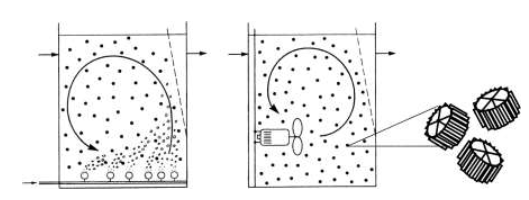
The reactor volume is filled with carriers up to a maximum value of 67%. Due to their density being close to that of water and the fact that only part of the reactor volume is filled with the bio-media, the packed bed is allowed to move freely in the reactor as can be observed in Figure below, hence the name moving bed biofilm reactor. Medium bubble aeration or mixing by slow-speed mixers is applied to keep the carriers in suspension and also in order to control the biofilm thickness.
The waste water treatment using MBBR process involve the below processes

i. The Flow equalization chamber
This chamber act as waste water holding facility for the MBBR systems before being pumped in to the plant by the help of the side hill screens. The chamber is continually aerated with the help of the blowers to help remove bad odor and break down the fine suspended solids. This chamber makes the MBBR method flexible in that in the case of plant technicalities, the plant stores waste water temporarily as the plant undergoes repair and maintenance.
ii. Aeration chambers
The aeration chambers are aerated entirely with the help of diffuser channels. These chambers contain floating plastic bio-media that is suspended and moves freely in the continuously aerated mixed liquor. They are perforated circular like balls made up of non-degradable plastic with a biofilm made of propylene and filling carrier that provide a surface area for the attachment and growth of the microorganisms as they rotate.
The perforations vary with the type of the bio-media ranging from 350m2/m3 – 800m2/m3. The small perforations increase the surface area reducing the foot print of the tanks that would rather be used to treat the waste water hence increasing the rate of degradation of the suspended solids.
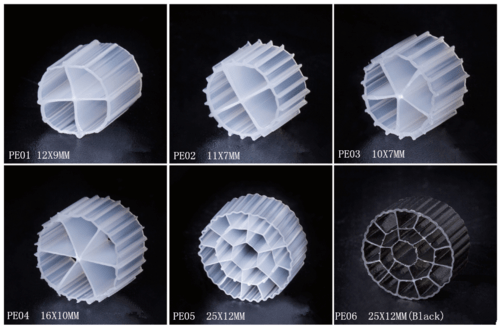
This bio-media is preferred rather than other biofilms because;
• They provide a large surface area for attachment of microorganisms and they are evenly distributed as the mixed liquor is being aerated, they move randomly in the chambers.
• They do not block easily as the perforations are of suitable size for bacteria interactions with the suspended solids.
• They are easy to maintain since they do not get worn out and if the biofilms are worn out, they can easily be replaced.
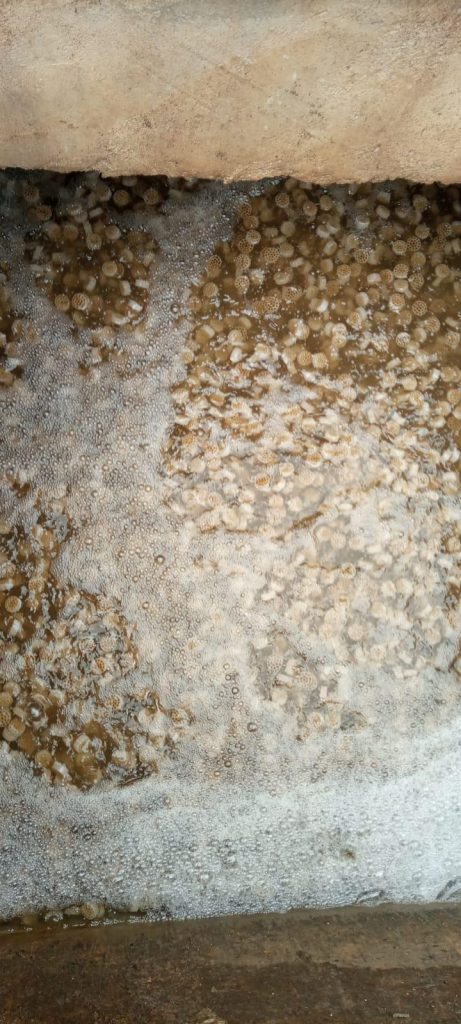
iii. The Clarifiers
Most of the MBBR designs have clarifiers for sludge removal, skimming of floating flocs, fats, grease and oils and they also have weirs that are designed to regulate the speed of the moving mixed liquor to help ambient settling of the sludge particles at the bottom of the hopper. They use the pressure mechanisms for all these processes. These chambers have a hopper that is in a V shape to increase sludge settlement at the clarifiers and easy removal by the desludging pipes.
The skimmers are efficient in the removal of the fats, grease and oils making this method suitable for commercial industries dealing with food products. The clarifiers have a higher sludge holding retention time hence giving it time for decomposition and breakdown of the nitrogenous waste present in the sludge. Since these chambers are not aerated the nutrients present in the sludge are broken down and removed through nitrification process improving the quality of the effluent. In this chamber most of the nitrogenous waste is removed.
Advantages of MBBR
a. Compared to Extended Aeration waste water treatment systems they occupy a smaller space.
b. It is suitable for handling large volume of generated waste hence good for industrial as well as large residential estates.
c. Has a higher sludge retention time that facilitates the removal of nutrients from the sludge through nitrification of the nitrogenous compounds in the mixed liquor.
d. It has a low sludge production since some of the sludge is recycled back for seeding the aeration chambers.
e. It is suitable to handle chemicals and can readily deal with the fats, grease and oils.
Membrane Bioreactor (MBR) Wastewater treatment process.
This technology uses a membrane or a ‘perm-selective’ membrane such as a microfiltration or ultrafiltration. The membrane is porous and allows the passage of water and dissolved solids while restricting the passage of solid materials on the other side of the membrane. The retained solids are decomposed and broken down by the presence of microorganisms into finer solids that can pass through the membrane as a mixed liquor.
The remaining solids are removed as sludge in to the sludge facilities. This method employs the technique of the activated sludge system only that it doesn’t require settlement tanks for the removal of sludge. This reduces the number of suspended solids in the effluent generated and with lesser number of pathogen population improving its quality.
The membrane selectivity depends on the pore sizes which ranges from microfiltration range of 0.1-0.4 μm to the coarse ultrafiltration range of 0.02- 0.1 μm. This system has a good solid retention time hence providing more for microbial activity on the solids ‘bio treatment’. The membranes are made up of ceramic or polymeric materials.

Properties of the Membranes used;
- They should be strong enough for mechanical and structural efficiency
- Should be highly porous to increase the surface area of solids permeability.
- The pores should be narrow and well distributed to provide high solid selectivity as possible.
- The material used should be resistant to chemical corrosion, temperature and pH.
The Design and mechanism
i. Flow equalization
This chamber acts as a waste water holding facility before its pumped in to the plant for treatment. It is equipped with a pumping mechanism that pump water into the anoxic chamber. The design depends on the volume of waste generated.
ii. Anoxic chamber
This chamber is air tight to create room for anoxic processes such nitrification on the nitrogenous waste present in the waste water before it enters the aeration chambers. This reduces the nutrient load of the final effluent improving its quality.
Depending on the waste water capacity, the anoxic chambers can be several with a minimum of two designed to operate in a sequence from one chamber to another. Municipal and domestic waste contain most the nitrogen load.
iii. Aeration chambers
Water from the anoxic chambers is fed in to this chamber where it is continuously aerated by the help of air generated by air blowers.
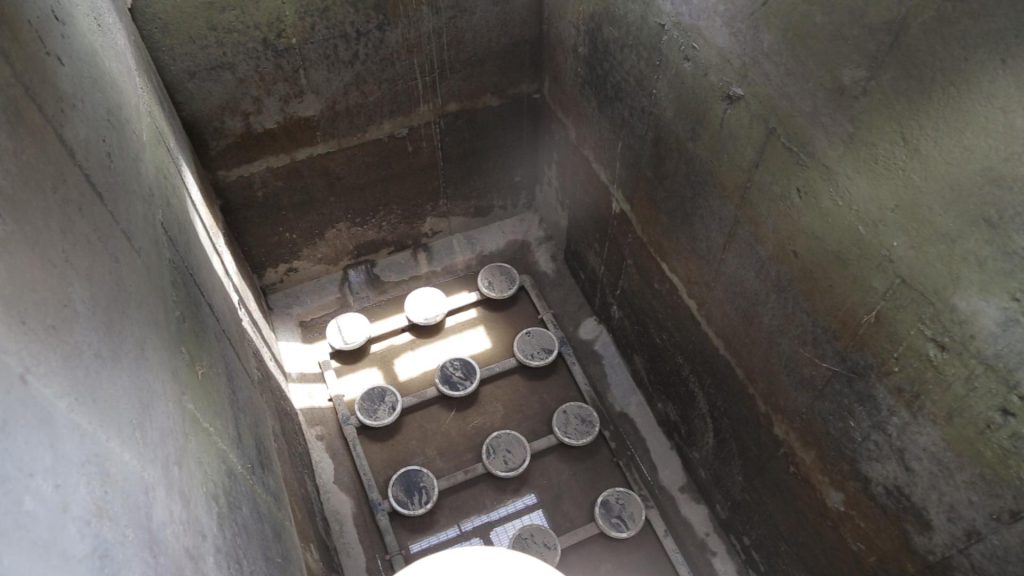
This provides ambient environment for breakdown and consumption of the carbonaceous organic suspended solids. They have media strands that are thread like that provide a large surface area for microorganisms’ attachment for faster breakdown and decomposition of suspended solids.

The mixed liquor moves by the help of the gravity. The chamber as well can be as many according to the capacity volume of waste water generated.
iv. Membrane chambers
This chamber contains the membranes that filter out the suspended solids from the aeration chambers through a selective technique allowing only the dissolved solids and water to pass through. It is equipped with mechanized suction system that help in the suction process of the water and dissolved solids through the membranes.
The retained solids are again worked on by the microorganisms and broken down to finer suspended solids that can pass through the membrane as mixed liquor suspended solids. The remaining solids are collected as sludge by a sludge suction pump to flow equalizer chamber reducing the number of suspended solids in the effluent.
The membranes suffer fouling and hence need frequent maintenance like washing off the solid particles that clog the membranes. They are also not suitable dealing with fats, grease and oils since they may form scum that will clog the membrane pores.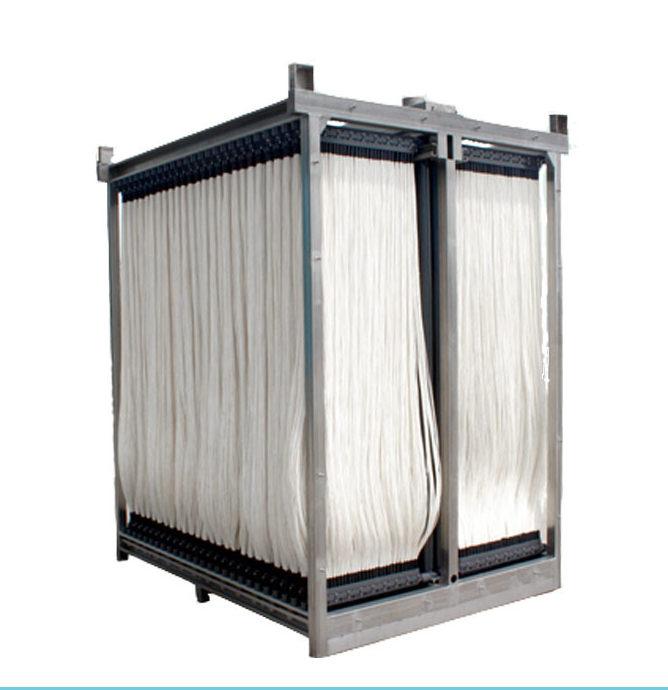
v. Treatment and storage
The effluent produced is treated through chlorination that is constantly dosed by the help of a chlorine dosing pump. Since the quality of the effluent contain less
suspended solids, the chlorine dosed is enough for free chlorination that is used for disinfection before the water is pumped for storage.
Advantages of MBR
a. Improved effluent quality with low suspended solids hence low BOD5 and COD load.
b. It has a small footprint in the treatment of waste water due to high solid retention time with a high effluent production that is independent of hydraulic retention time.
c. It has a better bio treatment of waste due to a longer retention time hence improved effluent quality.
d. It can utilize a smaller space area while at the same time treating large volume capacity of the generated waste water. Making it a viable option for commercial wastewater treatment plants where there is little space available.
e. It is very effective in the removal of waste water nutrients i.e. nitrogen and phosphorus through the anoxic chamber.
How Activated Sludge Wastewater Treatment Works.
Wastewater treatment aims to get rid of the contaminants in wastewater to produce clean effluent. There are different treatment technologies to achieve this end, here we will go through the activated sludge treatment process. The process uses bacteria that biologically digests the solid matter in the wastewater to leave clean effluent as a final product.
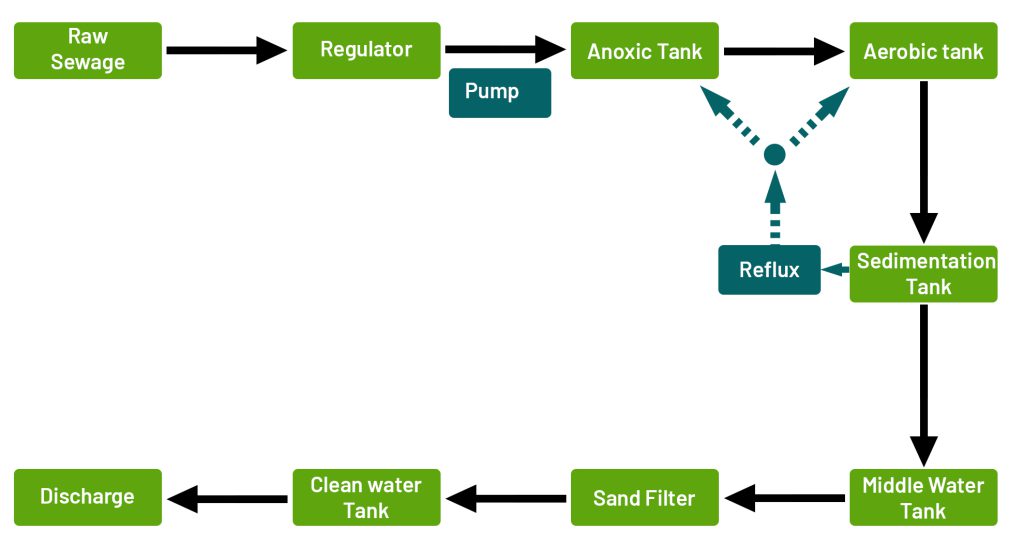
Flow regulation.
The flow equalization chamber receives the raw wastewater. A screen filters the raw wastewater going into the first chamber, large solid matter as well as material that can not be broken down by the system is filtered out. Undigestable material may include fabric, pads, surgical masks etc.
Often issues in the wastewater treatment plant arise because of undigestable solid matter clogging up different stages in the treatment process (e.g. clogging pumps in the system) hence the screening process is very important.
The content and rate of flow into the system varies throughout the day hence this chamber aims to homogenize the wastewater as it goes into the system.
Anaerobic digestion.
The digestion process starts in this chamber. Bacteria breaks down the wastewater without using oxygen hence an anaerobic process. At this stage the bacteria breaks down the nitrogenous components of the wastewater.
Aerobic digestion.
In this stage, the effluent shall be treated in extended aerobic biological reactor. The system is designed for extended aeration mode where excess oxygen is provided for oxidizing the carbonaceous as well as the nitrogenous BOD present in the effluent.
The organic wastewater is introduced into a reactor where an aerobic bacterial culture is maintained in suspension. The reactor contents are referred to as the Mixed Liquor Suspended Solids (MLSS). In the reactor, the bacterial culture carries out the conversion in general accordance with the stoichiometry as under:
Reaction:
COHNS +O2 + NUTRIENTS –bacteria- CO2+NH3+ C5H7NO2+ other end products (Organic matter)
The aerobic environment in the reactor is achieved by the use of Mechanical Surface Aerators, which also serves to maintain the reactor contents in a completely mixed regime. After a specified period of time the mixture of new cells and old cells is passed into a secondary clarifier, where the cells are separated from the treated wastewater.
A portion of the settled cells is recycled back to the aeration tank to maintain the desired concentration of organisms in the reactor, and a portion is wasted. In this system due to the extended retention period in the reactor the bacteria enters into the endogenous respiration phase resulting in relatively simple end products and energy, stable end products are also formed. The endogenous respiration phase is represented by following equation:
Bacteria
C5H7NO2 + 5 O2 —————-CO2 + 2H2O + NH3 + energy
The effluent will then flow into the sedimentation tank.
Sedimentation
The effluent moves to the next chamber where it settles. Any remaining solid material settles to the bottom of the chamber. Clean water from the top of the chamber is flows into the next chamber.
Any solids that settle in this chamber are refluxed back to the anaerobic chamber where the solid matter is taken through the digestion process again. The material that settles at this stage also contains bacteria which can be reused to avoid need for constant repopulation of the bacterial in the system.
Middle water tank.
For systems that have additional filtration of the effluent, the middle water tank acts as temporary storage before filtration.
Sand filtration.
A sand filter removes any remaining suspended solids from the effluent.
Clean water tank.
The clean water tank stores clean effluent ready for use.
The effluent can be disinfected by adding chlorine.. Depending on local regulation the effluent may be drained away or used for irrigation, gardening etc.

The activated sludge treatment process is a relatively simple, it is generally cheaper and easier to maintain. It can also be scaled up, from domestic systems to larger commercial systems.
